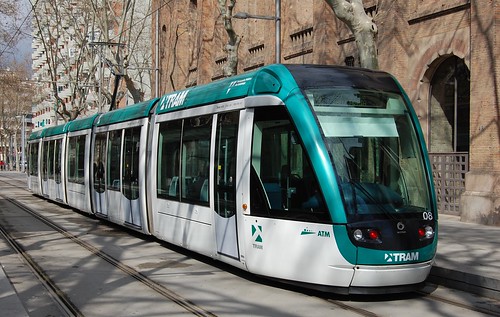
As mentioned here on Spacing Toronto in July, the TTC rejected the two remaining TTC streetcar replacement bids by Bombardier Transportation (as its model was deemed not to fit the TTC’s tight curve radii), and the small British firm TRAM Power (for not being commercially compliant). After this surprising turn of events, the TTC is re-opened the proposal, and Siemens (which withdrew from the bid process mid-way), Bombardier, and now Alstom, will enter into negotiations. Formal approval for entering into bid negotiations with all three builders will be presented at tomorrow’s commission meeting.
There were strong rumours that Alstom, with its with its Citadis LRV model, was all-but-chosen as the successful bidder, fueled by Christina Blizzard’s column in last Friday’s Toronto Sun. It appears that this is not quite the case, though it is noteworthy that Alstom did not submit a bid during the first round.
The 25% Canadian content requirement is a complication for all firms, particularly French-based Alstom and German-based Siemens, and only Bombardier has the facilities here in Canada for the production of rail transit vehicles. However, this 25% does not require final assembly to take place in Canada, it only requires 25% of the total value of the vehicles to be manufactured here. As well, the TTC’s tough requirements for its legacy streetcar fleet (which will not include the planned Transit City lines) has made ordering an off-the-shelf streetcar difficult.
As for the local content rule, it should be noted that southern Ontario should be a rich market for LRVs, so it might still make sense for final assembly to be done close to home, no matter who wins the bid. Bombarider’s Thunder Bay plant will be busy with GO Transit and subway orders as well. The TTC will need replacement street railway vehicles, as well as a new fleet for the Transit City light rail system. Additionally, Mississauga/Brampton, Hamilton, Kitchener-Waterloo, and Ottawa also have light rail plans of their own, and will need new vehicles.
Also on the agenda for tomorrow’s commission meeting are a proposal to end “free” parking for Metropass holders, and a plan to end the use of biodiesel in the TTC fleet.
Photo of Barcelona Citadis LRV courtesy of .Robert.


3 comments
There is the current system, which is for better or for worse not going to modernize, and then there are the Transit City routes. These are two different systems that need two different vehicles. The current order should be a Portland-streetcar type vehicle that can take the tight turns, rough rail alignment, etc. of downtown, while Transit City will require big, multi-car, fast-moving LRTs that run on right of way or in tunnels. Why is the TTC trying to end up with the worst of both worlds by mashing out an unrealistic compromise that handles both?
Actually, what uSkyscraper suggested is precisely what the TTC is doing. The order for 204 replacement streetcars for the current system is to be one type of car, with the remaining Transit City cars to be modern, double-ended light rail vehicles.
Gillian Jones wrote, “The order for 204 replacement streetcars for the current system is to be one type of car, with the remaining Transit City cars to be modern, double-ended light rail vehicles.”
Yes and no. The legacy replacements will be single-ended (operator’s control at one end, doors on the right side only), while Transit City LRVs will be double-ended (operator’s control at both ends, doors on both sides). Both cars, however, would be 30-metre long cars.
The RFP was just for the legacy replacements, but mentioned a possible extension for TC vehicles.
This suggests that the TTC was open to either a totally separate vehicle for each, or for a vehicle that used the same modular components with certain components different for the two models.
Two versions of the same vehicle would certainly have some advantages, particularly in the area of maintenance, since the processes would be similar and common spare parts inventory could be kept. On the other hand, if a major defect required pulling the model out of service, that would be very significant if both cars were the same at this level.
I suspect also, that trying to shoehorn an off-the-shelf vehicle to the legacy system might prove to complicated and/or expensive for the benefits received. We may see two different cars, possibly from two different manufacturers, in the end.